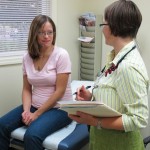How Idaho Is Trying To Boost Its Number Of Doctors

Emilie Ritter Saunders / StateImpact
Idaho has fewer doctors per capita than every state in the nation except one.
A few years ago, the Idaho Board of Education, which oversees colleges and universities in the state, put together a list of priorities to increase the number of doctors in Idaho.
While nearly every state in the country is facing a shortage of doctors to a certain extent, there are fewer doctors per capita in Idaho than every state in the country except Mississippi.
At its April 2009 meeting, the board agreed to work on 10 things. Just four have been fully or partially implemented.
Idaho Board of Education 2009 Recommendations
- Expand the development of graduate medical education (residency) opportunities in the State of Idaho focusing on primary care and rural practice. In partnership with Idaho hospitals, the VA, Idaho doctors, private enterprise and Idaho’s colleges and universities, the State of Idaho should promote and assist the funding of these programs. (Implemented in part)
- Immediately increase the state funding support for Idaho WWAMI students to expand the number of seats from 20 per year to 40 per year (adding 10 per year over the next two years) and encourage the WWAMI program to establish the full four years of medical education opportunity in Idaho.
- Expand the total number of medical seats for Idaho-sponsored students to between 60 and 90 per year (an aggregate total of 240 to 360) as soon as practicable through partnerships with WWAMI, WICHE, University of Utah, osteopathic schools and other medical schools taking into consideration the following factors; quality, return rate, cost effectiveness, retention
- The State Board of Education will oversee an initiative to engage all stakeholder groups (ISU, UI, BSU, LCSC, University of Washington, VA Medical Center, the hospitals, and the Idaho Medical Association) to jointly develop a collaborative and comprehensive plan for establishment of a 4-year, Idaho-based MD program.
- Encourage medical school admission committees to use selection criteria for admission into Idaho-sponsored medical seats which maximize potential for practice in primary care and rural areas. (Implemented)
- Work with sponsored medical programs to insure that Idaho medical students participate in an Idaho rural rotation as part of their program. (Implemented)
- Expand and enhance the current Idaho Rural Physician Incentive Program (RPIP) to help recruit to rural Idaho. (Implemented)
- Consider providing a tax incentive for physicians practicing in rural Idaho.
- Increase Medicaid reimbursement rates for primary care physicians.
- Consider developing a pay-back provision for Idaho sponsored medical school seats. [Meaning, a requirement for WWAMI/University of Utah graduates to work in their home state a certain amount of time]
It wasn’t the best time to embark on an ambitious push. April 2009 was the height of the Great Recession. The following legislative session, Idaho lawmakers began a series of budget cuts to just about every program the state funds.
Adding money to medical education programs like WWAMI — an initiative that sends Idaho students to the University of Washington’s medical school — wasn’t possible, says Idaho Board of Education executive director Mike Rush.
“From a budgetary standpoint, we went into protect mode,” says Rush. “How can we save what we have?”
The Board of Education was able to maintain existing funding for 20 medical education seats at the University of Washington and eight at the University of Utah. It’s also been able to expand residency programs that are based here, which was the first item on its list of recommendations.
But the second and third items on that list from 2009 haven’t become a reality. Rush still wants to add at least 20 more seats to the WWAMI program, doubling the number of first-year med school students at U-W. He also wants to expand seats through other partnerships for dental school and osteopathic schools.
As StateImpact reported last week, the Board will start small this year, asking state legislators to fund five additional WWAMI seats. That would cost Idaho about $250,000 more per year.
Incentives For Rural Doctors
Since 2009, the Board of Education also has increased its maximum payment under the Idaho Rural Physician Incentive Program. It’s a loan repayment program for doctors who move to a rural part of the state to practice. While physicians from any medical school can apply, preference is given to WWAMI and University of Utah graduates. The incentive program is paid for in part by med student fees. Doctors can be reimbursed for up to $50,000 in student loans.
Idaho also offers an incentive program for communities to recruit doctors and improve access to health care. The Rural Health Access Program is also paid for in part by student fees. Idaho Medical Association CEO Susie Pouliot says communities or a non-profit hospital or clinic can use the program to offer doctors signing bonuses or loan repayments, tele-health projects and community development.
The numbers this year show there is a need for it. According to Pouliot, 21 grant applications have been submitted for the Rural Health Access Program funds. Applicants asked for almost $600,000 — way more than the $183,000 available for 2013. “The need versus the resources is way out of whack,” Pouliot says.

